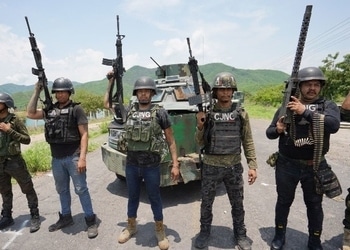Organized crime groups are increasingly driving violence in Mexico’s worst affected areas, a new report has revealed.
Murders related to organized crime have almost tripled since 2015, from 8,000 to 23,500 annually, according to the Mexico Peace Index 2023, published on May 23 by global development think tank, Institute for Economics and Peace. During the same time, homicides not linked to organized crime have remained between 10,000 and 12,000 per year.
Below, InSight Crime examines the report’s findings regarding where violence is concentrated and which criminal economies and crime groups are spurring the most violence.
Evolving Criminal Dynamics Alter States’ Violence Levels
Shifting organized crime dynamics can rapidly escalate violence within specific locations, the report found.
Colima, the most violent of Mexico’s 32 states in 2022, has experienced a sharp rise in insecurity since 2015, largely due to the rise of synthetic drugs. Its port of Manzanillo acts as an arrival point for precursor materials used in the production of methamphetamine and fentanyl, leading drug trafficking organizations to fight for control of the area.
Durango, by contrast, saw one of the largest improvements in peacefulness last year, which the report attributed to the Sinaloa Cartel’s increased dominance in the state and subsequent reduction in clashes involving rival factions.
Some states, like Baja California and Chihuahua, saw little change in levels of violence. These border states are key areas of control for organized crime groups, which have long battled over them and continue to do so.
SEE ALSO: Mexico Drone Attacks Spike After CJNG, Familia Michoacana Alliance
Nevertheless, the country’s violence hotspots have varied considerably during the past 15 years, Cecilia Farfán-Méndez, research head at the University of California, San Diego’s Center for U.S.-Mexican Studies, told InSight Crime. Guanajuato, the fourth most dangerous state according to the report, is one example.
“Whereas in 2010 nobody discussed Guanajuato, today it is one of the states making headlines,” she said. “In 2009-2010, discussions of violence were centered on Ciudad Juarez, Tamaulipas, and Sinaloa.”
Changing criminal dynamics mean there is no guarantee that zones currently considered relatively safe are likely to remain so. The southern state of Chiapas, which borders Guatemala, could be representative of this phenomenon, Crisis Group analyst Falko Ernst told InSight Crime. While the report named Chiapas as Mexico’s third most peaceful state, clashes between organized crime groups have displaced thousands of inhabitants along the border with Guatemala this year.
“Looking down the line and given the absence of a containment strategy, the risk is that further areas of the country will become affected in similar ways,” Ernst said.
A Variety of Criminal Economies
Another finding concerned the trafficking of synthetic drugs as a primary driver of criminal violence in Mexico, although other criminal economies also contribute significantly.
Extortion and microtrafficking have grown rapidly in recent years, increasing violence as retail drug outfits fought over control of local consumer markets while extortionists and kidnappers legitimized their threats with violence and murder.
The growth of these criminal economies came in response to the collapse of others. Mexico’s marijuana economy dramatically reduced in size following the legalization of marijuana in multiple US states. This forced criminal organizations that traditionally trafficked marijuana to diversify their criminal portfolios in search of new revenues.
The existence of one criminal economy in an area can lead to a proliferation of others.
In Guanajuato, ”huachicol” (gasoline theft) gave rise to multiple criminal groups, including the Santa Rosa de Lima Cartel. But huachicol groups have since diversified into other crimes, and, according to the report, Guanajuato is now the country’s most active local drug market.
The CJNG Increasingly Violent
The Mexico Peace Index 2023 also determined that the ascendance of the heavily armed and trigger-happy CJNG in recent years has fueled much of the increasing bloodshed.
The Jalisco Cartel New Generation (Cartel Jalisco Nueva Generación – CJNG) was involved in far more murders resulting from “cartel conflicts,” meaning violence involving the country’s largest criminal organizations, than any other crime group. This group and the Sinaloa Cartel were allegedly involved in 95% of all deaths from “cartel conflicts” in 2021, up from 42% in 2015. Homicide cases involving both groups have exploded since the breakdown of their alliance after the 2017 extradition of the latter organization’s leader, Joaquín Guzmán Loera, alias “El Chapo.”
SEE ALSO: 5 Takeaways From US Indictments of Chapitos, Associates
The CJNG’s use of military tactics, weaponry, and drones as weapons, exemplifies the “militarization” of criminal groups that Guadalupe Correa, author of “Los Zetas Inc.” and professor at George Mason University, blames for Mexico’s violence.
“There’s more access to high-caliber weapons than ever. The militarization of criminal groups has not stopped,” she told InSight Crime.
In keeping with its militarized approach, the CJNG’s numerous alliances with other criminal organizations have allowed it to expand rapidly. But when those alliances break down, the group is involved in more violence, Marisol Ochoa, expert on criminal dynamics from Mexico’s Ibero-American University, told InSight Crime.
“They are creating alliances with other groups that are not necessarily maintained, which also implies that they may have great possibilities of expanding, causing terror, and co-opting territories,” she said.
Beyond the fragility of alliances, the CJNG’s disproportionate violence may also be explained by its internal structure. Rather than a monolithic organization, it is better thought of as an extensive series of largely independent cells working under the CJNG label, Correa suggested.

